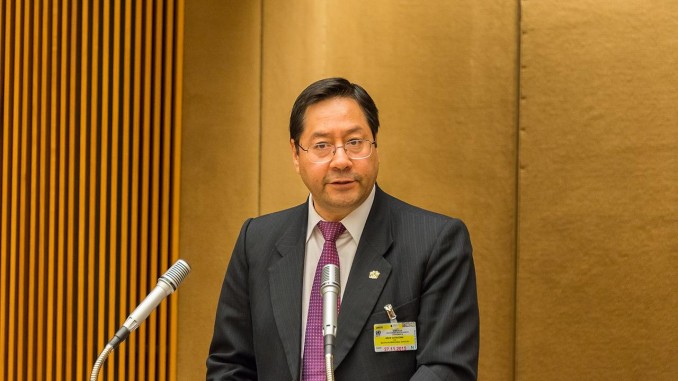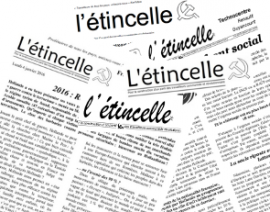
November 7, 2020
Translated from Convergences revolutionnaires, a publication of the fraction Etincelle of the NPA (New Anticaptalist Party) in France
On October 18, Luis Arce, the MAS (Movement For Socialism) candidate, won Bolivia’s presidential election in the first round with 55.10% of the vote, compared to 28.83% for his main rival from the center-right, Carlos Mesa and 14% for Luis Fermando Camacho, who represented the extreme right. This was a slap in the face for the putschists who overthrew Evo Morales on November 10, 2019. Morales, following riots sparked by accusations of rigging the October 2019 election, was forced to resign under pressure from the army. Morales, a refugee in Argentina, was unable to participate in the new elections. The MAS was represented by Luis Arce, who for 14 years was Morales’ Minister of Economy, with David Choquehuanca as the candidate for vice-president. Morales presented this pair as “the alliance of the indigenous with sane whites” . From exile, Morales did not renounce indigenous idolization. Ironically, although Choquehuanca wears indigenous style of dress and is of Aymara origin (an indigenous nation in the Andean high planes), he comes from a very rich family that has maintained its social position since the Spanish conquest, particularly by providing men to fight in the Tupac Katari revolt of 1781. Luis Arce is a very moderate economist whose first official statements were calls for national unity. He is scheduled to meet with the other candidates to try to reach some agreements.
The MAS, during fifteen years of reign
The situation in Bolivia today is very different from that of 2005 when Morales was first elected with popular enthusiasm after several uprisings had driven out of power the same Carlos Mesa, who had just tried unsuccessfully to return to power. The MAS (Movement For Socialism), a coalition of labor unions, several peasant associations, associations of merchants and artisans, and also the powerful federation of mining cooperatives, carried the hopes of the working classes (these cooperatives often function as capitalist enterprises, and foreign investors often participate in their capital). During its fifteen-year reign, the MAS was plagued by corruption and favoritism. Some of its members became part of the system, while others were replaced by status seekers.
Bolivia has had some development, but its economy has been based primarily on the sale of raw materials such as gas, oil and lithium, which it cannot afford to exploit without the capital and technology of the imperialist states. Shortly before the fall of Morales, agreements had been signed with Chinese and German companies for the extraction and processing of the enormous lithium reserves in the Uyuni Desert, considered the largest in the world. These agreements enraged those who would have preferred to entrust this pact to U.S. companies, especially the bourgeoisie of the province of Santa Cruz (Bolivia).
With the development of a state bureaucracy and a middle class, the royalties generated by this exploitation of raw materials benefited only a fraction of the population and did not change the fate of the vast majority of peasants, miners, and workers. This may explain the limited reactions to the overthrow of Morales, especially since the MAS leadership has been careful not to encourage them. Moreover, the new middle class was not grateful to Morales and contributed greatly to his downfall.
How the putschists discredited themselves
However, the behavior of the putschists (those who participated in the coup against Morales), whose figurehead was Jeannine Añez, a former ultra-reactionary TV personality, provoked revolt. Añez herself inaugurated her power by burning a “wiphala”, the traditional Aymara flag, in the presidential palace and by amplifying racist statements. The putschists violently suppressed several attempts at revolt, including an attempt to blockade the El Alto airport, which serves La Paz, killing dozens of people. In the end, the newcomers quickly fell into shameless corruption. Recent scandals include the exorbitant purchase of large amounts of expensive yet non-functioning ventilators.
The transitional regime of Añez thus quickly fell into disgrace, even among the middle classes. In particular, the management of the COVID-19 crisis was catastrophic: with 769 deaths per one million inhabitants, Bolivia ranks third worst in the world after Peru and Belgium. Again, these figures are probably an underestimation because a certain number of COVID-19 victims died in their villages, far from any hospital where they could be tested. While the health budget had increased under Morales, its resources are still vastly insufficient.
Añez and her friends, who undoubtedly felt her growing discredit, tried to postpone the presidential election, using the pretext of the epidemic, but this attempt came up against various movements, especially in the countryside, with roadblocks, the traditional form of struggle of Bolivian peasants.
A government of national unity to make the population accept sacrifices?
In fact, it is mostly due a rejection of the putschist power—identified as reactionary, favorable to US imperialism, racist, corrupt, and incapable of dealing with the epidemic—that the majority of the population came out in favor of the MAS’s Arce and Choquehuanca. The extreme right is now trying to object to its resounding electoral failure by organizing blockades in the regions of Oriente that it controls (Bolivia is a federal state with nine provinces that are governed by governors and enjoy a certain degree of autonomy), including the province of Santa Cruz, the richest province in the country thanks to oil, and whose bourgeoisie has always dreamed of seceding from the rest of Bolivia. But this attempt will probably fail. Various institutions such as the Constitutional Court and the Supreme Court have recognized the validity of the election. The Church itself, after some hesitation, did not protest, and the army’s ruling circles did not exercise their power.
Luis Arce’s mandate is taking place in a difficult context, with the continuing epidemic and an 11% decline in GDP, while the economy was already running out of steam on the eve of Morales’ fall. He made only very modest promises, such as the creation of food vouchers and the study of a wealth tax. Bolivia’s debt has increased, and Arce will try to renegotiate it with the IMF (International Monetary Fund). Arce places much hope in the exploitation of lithium and announced the creation of 41 national companies for this purpose, but it is difficult to see how he will succeed without the capital and technology of the great powers. He is trying to restore a consensus and is careful not to call on his supporters to mobilize. His plan for a government of national unity, if it sees the light of day, will be a policy of compromise that will not question the privileges of the bourgeoisie. The Bolivian population, for their part, probably has fewer illusions in the return of Arce than the Third World intellectuals who praise him. They were able to mobilize to prevent Añez from postponing the elections and hopefully, Bolivian workers, miners, and peasants will be able to defend their interests as they have always done.


